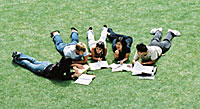| Nightlife and the Metropolis: Moulin Rouge to Rave - HIST2751 |
|
|||||||||||||||||||||||||||||||||||||||||||

Description Traces the unfolding of a global culture of nightlife in the twentieth century, thus providing a window into modern urban cultural history. Examines how nightlife spaces created new forms of sociability, fashionability, sexuality, and identity for modern urbanites. Other influences on the growth and spread of nightlife include imperialism, colonialism, and war; advances in media technologies such as radio, film, television, and recording; and the role of criminal organisations and narcotics in building modern nightlife industries. Emphasises East Asian cities such as Tokyo and Shanghai.
Learning Outcomes Students will sharpen their analytical, writing and communication skills through a combination of tutorial exercises and essays, as well as in preparation for exams. Specifically, students will learn more about the history of modern Europe, the United States, China and Japan through the unique and fascination lens of nightlife in four major world cities.
Assessment
|
||||||||||||||||||||||||||||||||||||||||||||

| Contacts | Library | myUNSW | WebCT |